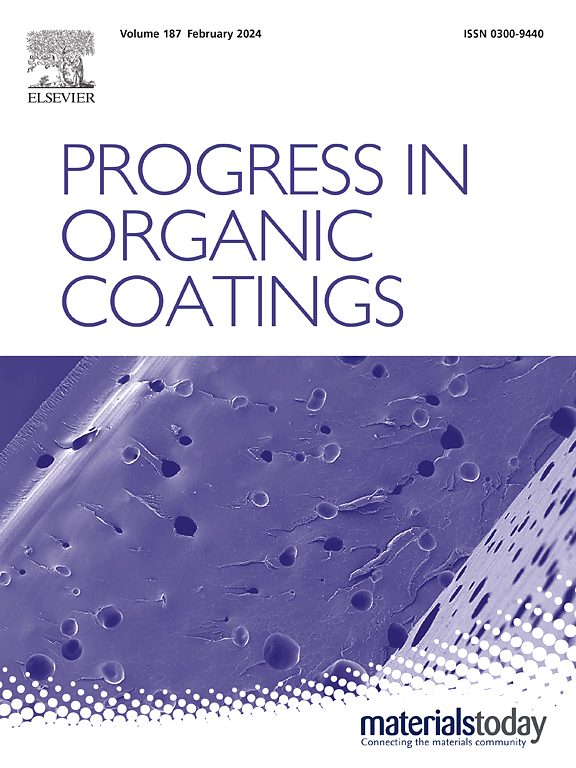Solvent-free epoxy coatings with enhanced cross-linking networks towards highly-efficient flame retardancy, water resistance and anticorrosion
IF 6.5
2区 材料科学
Q1 CHEMISTRY, APPLIED
引用次数: 0
Abstract
Developing robust flame-retardant epoxy-based coatings that provide protection against fire, high temperatures, and prolonged exposure to wet environments remains a significant challenge. In this work, a facile and effective strategy is developed to enhance the cross-linking network and charring ability while reducing VOCs emissions in epoxy (EP) coatings. By exploiting a charring agent-derived active diluent, pentaerythritol glycidyl ether (PTGE), in combination with ammonium polyphosphate (APP) and EP, a solvent-free EP coating with enhanced flame retardancy, water resistance, and anticorrosion properties is constructed. With its low viscosity and multifunctionality, PTGE, anchored by four epoxy groups, reduces the coating's viscosity and strengthens the cross-linking network, thereby improving water resistance and anticorrosion properties, achieving an adhesion force that meets the ASTM 5B standard. The ring-opening of PTGE produces abundant hydroxy groups, and the synergistic effect of PTGE and APP provides excellent flame retardancy to wood, as evidenced by a limiting oxygen index of 29.2 % and a 40.0 % reduction in peak heat release rate. With the formation of a dense and hard char layer, the maximum back temperature of coated structural steel remains as low as 75 °C after 2600 s of flame exposure. This study provides a feasible strategy for constructing multifunctional, solvent-free, flame-retardant protective coatings.
具有增强型交联网络的无溶剂环氧涂料,可实现高效的阻燃、防水和防腐性能
开发坚固耐用的阻燃环氧基涂料,以提供防火、耐高温和长期暴露于潮湿环境的保护,仍然是一项重大挑战。在这项工作中,开发了一种简便有效的策略来增强环氧树脂(EP)涂料的交联网络和炭化能力,同时减少挥发性有机化合物的排放。通过利用从炭化剂中提取的活性稀释剂季戊四醇缩水甘油醚(PTGE),结合聚磷酸铵(APP)和 EP,构建了一种具有更强阻燃性、耐水性和防腐性能的无溶剂 EP 涂料。由四个环氧基团锚定的 PTGE 具有低粘度和多功能性的特点,可降低涂料的粘度并增强交联网络,从而提高耐水性和防腐性能,使附着力达到 ASTM 5B 标准。PTGE 的开环作用会产生大量羟基,PTGE 和 APP 的协同作用可为木材提供出色的阻燃性能,其极限氧指数为 29.2%,峰值热释放率降低了 40.0%。由于形成了致密坚硬的炭化层,涂覆结构钢在火焰暴露 2600 秒后的最高背面温度仍然低至 75 °C。这项研究为构建多功能、无溶剂、阻燃保护涂层提供了一种可行的策略。
本文章由计算机程序翻译,如有差异,请以英文原文为准。
求助全文
约1分钟内获得全文
求助全文
来源期刊

Progress in Organic Coatings
工程技术-材料科学:膜
CiteScore
11.40
自引率
15.20%
发文量
577
审稿时长
48 days
期刊介绍:
The aim of this international journal is to analyse and publicise the progress and current state of knowledge in the field of organic coatings and related materials. The Editors and the Editorial Board members will solicit both review and research papers from academic and industrial scientists who are actively engaged in research and development or, in the case of review papers, have extensive experience in the subject to be reviewed. Unsolicited manuscripts will be accepted if they meet the journal''s requirements. The journal publishes papers dealing with such subjects as:
• Chemical, physical and technological properties of organic coatings and related materials
• Problems and methods of preparation, manufacture and application of these materials
• Performance, testing and analysis.
文献相关原料
公司名称
产品信息
阿拉丁
Ammonium polyphosphate (APP)
 求助内容:
求助内容: 应助结果提醒方式:
应助结果提醒方式:


